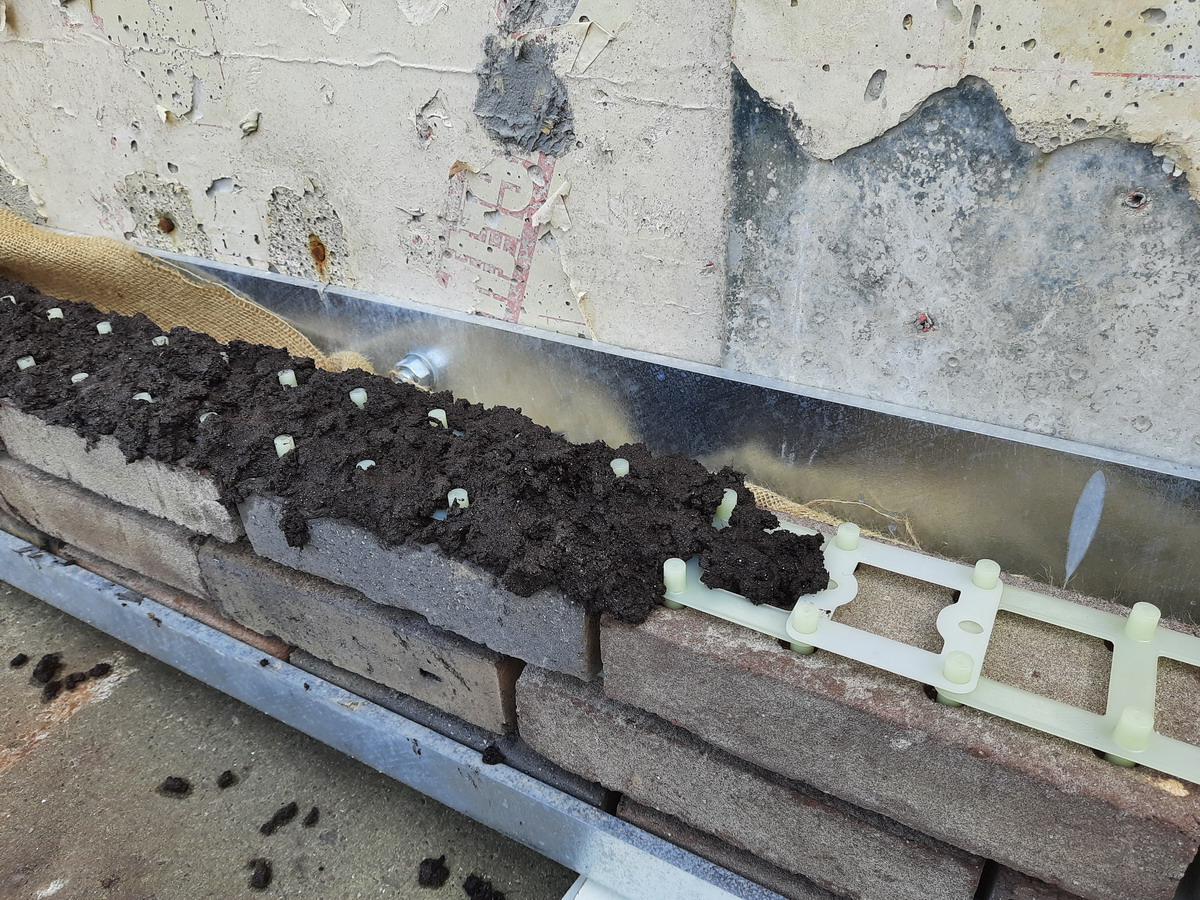Traditional brick quay walls - as in the inner city of Delft - are enormously thick porous brick walls that are in direct contact with the ground and the groundwater. As a result, the wall surface of the quay remains damp for a long time. An urban biotope for often unusual rock plant species, such as wall ferns, wallflowers or ivy-leaved toadflax. This plant growth is important for a green city and for biodiversity. Researcher Koen Mulder: "Modern quay walls are no longer made like this, however, and this is an impoverishment of natural greenery in the city. This is why we are researching new techniques for greening quay walls."
Steel sheet piling causes dry walls
Nowadays, the actual soil retaining quay wall is usually a steel sheet pile wall profile drilled into the ground. Much stronger and also much cheaper. Because this does not look so attractive, a 'concrete apron' is often hung over the steel sheet piling in inner cities, covered with brick. Koen Mulder: "The function of the brick is actually only to make it look more attractive. This covering for the concrete and steel does not come into direct contact with the moist soil behind. This brick layer therefore becomes very hot and dry on hot days, and is therefore not an ideal habitat for quay wall plants."
Test with quay wall cavity and mortar
In Breda, the river Nieuwe Mark is currently being restored to its former glory. New green-covered quay walls are also being created - with trees even growing out of them. The technique used there is a brick lining wall for the sheet piling with a cavity in between, which is filled with a moisture-absorbing layer (substrate). The brick wall still stands on an edge of the concrete in front of the steel and is not in contact with the soil behind. However, the substrate draws the canal water up behind the brick wall by capillary action and humidifies the bricks and mortar joints, creating the conditions for plant growth in the quay walls.
In Breda, extensive experiments were carried out with different brick thicknesses and especially with different mortar types. Strong enough for construction, yet sufficiently bio-receptive - pleasant for plants. One of the discoveries made during the research for Breda was that working with the Dutch traditional pointing joint, in which the constructive cement mortar is scratched out a few centimetres, after a special decorative joint is made. The best combination is then strong with still a very porous plant-friendly joint on the surface. "Plants can take root in that without damaging the underlying cement mortar," says Mulder.
Further trial set-up in Delft
In Delft, at the Graaf Floriskade, a follow-up to the Breda project is underway. After all, why would you glue the bricks together with hard cement mortar? That would only be inconvenient in case of possible reuse or maintenance. In Delft, the bricks are therefore stacked dry. To prevent the stone quay wall from becoming unstable, the bricks are drilled to a precise depth and stacked on long profiles with ridges. No matter how rough the stone, stone and profile together always have exactly the same height. The cavity is also filled with the capillary substrate that keeps the bricks moist. Mulder: "Here in Delft, we would also like to show that quay wall cladding can also be done in beautiful brick compositions. And the nice thing is: everything could be taken apart and reused."
Potting soil with bio glue
So the cavity in this project is also filled with capillary substrate that keeps the bricks moist. But here the researchers are looking at the most ideal joint for the plants, and that might be made of ordinary soil bound with a biological glue. That is why the joints in Delft have been filled with potting soil, and seeds of wallflowers and ivy-leaved toadflax were included for a kick start of the project. But they are also curious which pioneer species will eventually settle in the quay wall. They experiment with different brick patterns and especially the thickness of the substrate in the cavity behind. One part of the panel only receives water from the canals, while another part also receives rainwater from above that collects on the cover. The trial panels will be installed in end of April 2022. The development will be monitored over three summers. To this end, sensors have been placed at various heights in each half of the panel to measure the moisture content in the joint. Mulder: "But the most important thing is of course what we see happening on the surface. Which plants are germinating in the joints, which new species will soon be pioneering on the wall? Once every few months we make a record of this. The panels will be removed again at the end of 2024."
Published: April 2022
More information
- This project is led by researchers Barbara Lubelli, Koen Mulder and Max Veeger from the AE&T department of the Faculty of Architecture.
- See the project page 'Wall Garden' for more information and the partners.
- More information about the Greenquays project in Breda can be found here.


